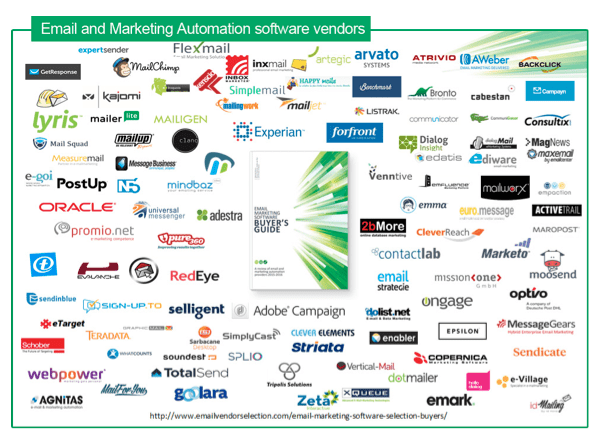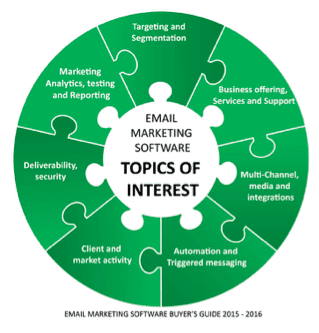Expert tips for choosing the right Email Marketing Software
Choosing the right email marketing software is tough. There is a jungle of vendors out there and it is often hard to see what all of the vendors exactly do? But before you go out and fire up google for a wild and unsatisfactory search, read on for some crucial tips on the process by Jordie van Rijn.
Jordie is the co-author of the recently published Email Marketing Software Buyer’s Guide, which is officially the biggest research ever on ESP and Marketing automation providers, has some tips for companies starting their selection.
The right order: No cups of coffee based on gut-feeling
Doing through the process in the right order is very important in a selection. The first step is to find out how you will be using the tool. Because only then it becomes clear what to look for in a potential vendor. That way you can make the right evaluation and choice.
Vendors often want to invite for Meetings / demo’s and “cups of coffee, No offense to the vendors for asking you for coffee – they just want to sell their tools. These usually cost a lot of time and
you don’t know which questions to ask (yet). First get a clear image of what you want. And what you want is not a cup of coffee.
Base the choice on your 20%
ESP selection time is the moment to be honest with yourself. The tool and supplier need to fit to what you intend to do with it and what your organisation deems important. Describe what you will do in the coming 12 – 24 months. I mention 12-24 months, because if you aren’t going to do it in the first two years, little chance that you will after that.
More functionality isn’t better. Of course it is nice to know the supplier has room for growth, but 80% of the users (exaggerated stated) only 20% of the tooling intensively. Of course there will be many innovations in email marketing, but the field is already quite mature. So make sure your selection is based on your 20% and that those are completely like you want them. You can write those wishes down in normal language and later distil a shorter requirement.
In our research we asked 350 questions. 69% of the vendors can for instance send SMS from their platform, but only 4% has a native function to send push messages to apps. If mobile messaging is important for your organisation, those are things to look for. If not, they don’t count.
Creating a long list – how does that work?
There are a lot of suppliers. A lot. Today the total number of Email service providers stands at 543 if you count the 143 I haven’t reviewed yet. So how to get to a workable list of ESPs to look into?
 Image: An overview of the 111 email and marketing automation vendors in the published Email Marketing Software Buyer’s Guide
Image: An overview of the 111 email and marketing automation vendors in the published Email Marketing Software Buyer’s Guide
A division between Small market (simple tools, relatively cheap, less functionality), mid-market (more functionality, often more support and send volume) and Enterprise (for big corporates and high demands) will help a lot.
As well as the selection between email centric, marketing automation or all-in-one. And the need for additional services and support. If you slice the market like that, you have got a category – the suppliers within that category would form your long list. But that is only the begin of the real selection.
1. There are Must haves and there are must haves
Your wishes can be prioritised according to the MoSoCoW method. The Mo -The Must Haves - form the absolute minimum requirements. If a vendor doesn’t fulfil those, they are disqualified. But even in the must haves are three categories:
Hygiene factors like security demand, hosting location, support hours or ISO certification are used to widdle down the list with potential suppliers. After the pre-selection they are no longer important for the selection, so they shouldn’t be further considered in the final decision.
Deal breakers, these must haves are what you would normally find to be a must have feature. For instance you want an easy to use email editor. But there is granularity. One vendors might have an email editor that is easy to use, but the second has one that is super easy to use.
Other Deal breakers might have an alternative solution. An example of that is a landing page maker, you can use an external tool to build the landing pages, or let your agency do it for you. Sometimes a bit more customization is needed, like with integrations for example. That is not ideal, but not per se a reason for exclusion.
So even “must haves” have multiple levels to distinguish.
2. Scoring by scoring
I use a scoring model when guiding selections. Such a scoring makes it clearer on what you are selecting and clarifies the considerations, also internally.
You give the requirements a score of importance, that way you can make a selection based on the right . Make sure the functionalities and requirements are grouped by category. Otherwise one category (with many items) can overshadow all other categories! There are 7 key features mentioned in this interview from some years ago. In our research we included 14 categories, this is mainly because not every selection criteria is a feature.

The model I use in selections that I guide is a bit more advanced than you would normally see. If you make your own scoring model, make sure the most important items get the highest value. The answer to “do they match this requirement?” should ideally not just be answered as yes or no. For in many cases it is not only the question if they do something, but how and how well it is done. Based on a scoring made in Excel you can get quite far.
3. The price is right
Price is also important of course. The cost of software differ hugely and often are not calculated in the same way.
Is it a fixed price per year, licence costs, number of emails sent, number of users, pay-as-you-go? What are the set-up and implementation costs?
With Marketing Automation tools, it is common to offer a package with functionalities and a number of contacts in the database. Do you want more, you go to a higher package. Or it is modular, in which case you pay extra per additional function. So here it is also important to know how you will be using the system.
.
The best way is to give the vendors a couple of scenarios, based on expected, higher rand lower volumes. That way there won’t be any big surprises once the usage is different than estimated.
But, and this is my own opinion, if tools and services are close enough to be in the same price-category, you would best drop price as a consideration all together and just go for the one that has the best fit.
The email Marketing Software Buyer’s Guide in short
The email Marketing Software Buyer’s guide is written by four international experts in ESP and Marketing automation selections. Jordie van Rijn, Bruno Florence, Torsten Schwarz and Gabriele Braun. is the ultimate selection cheat-sheet. and guide for the RFP and purchase process in 330 pages, 111 vendor profiles with in-software screenshots and contact information.

For more information on the guide or to requesting an abstract of the email marketing software buyer’s guide.
 Thanks to Jordie van Rijn for sharing his thoughts and opinions in this blog post. Jordie is an independent email and eCRM marketing consultant who helps companies get the most out of their digital efforts. He is the founder of the international platform for Email and Marketing Automation Software selection and author of the Smart Insights Marketing Automation Best Practices Guide. Brands like Unilever, EndeMol, KLM and Heineken turn to him for advice. Next to helping companies improve their marketing results, he is often asked as a trainer and speaker in the field of online marketing. His practical and enthusiastic approach is contagious and will have you sending better emails the next day. You can connect on LinkedIn.
Thanks to Jordie van Rijn for sharing his thoughts and opinions in this blog post. Jordie is an independent email and eCRM marketing consultant who helps companies get the most out of their digital efforts. He is the founder of the international platform for Email and Marketing Automation Software selection and author of the Smart Insights Marketing Automation Best Practices Guide. Brands like Unilever, EndeMol, KLM and Heineken turn to him for advice. Next to helping companies improve their marketing results, he is often asked as a trainer and speaker in the field of online marketing. His practical and enthusiastic approach is contagious and will have you sending better emails the next day. You can connect on LinkedIn.






 Thanks to Jordie van Rijn for sharing his thoughts and opinions in this blog post. Jordie is an independent
Thanks to Jordie van Rijn for sharing his thoughts and opinions in this blog post. Jordie is an independent 


